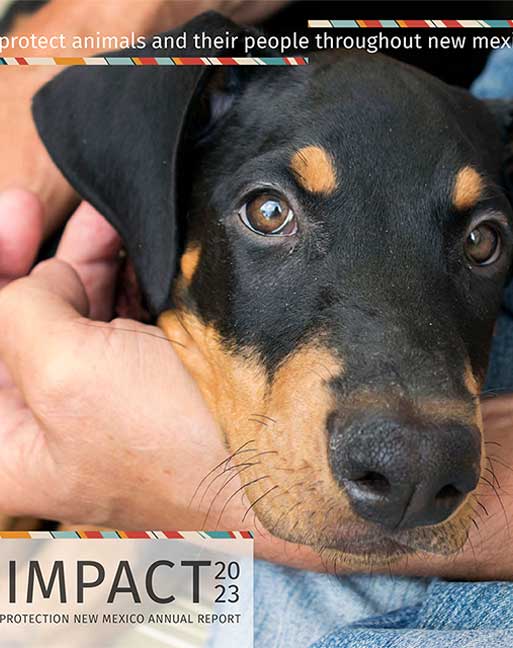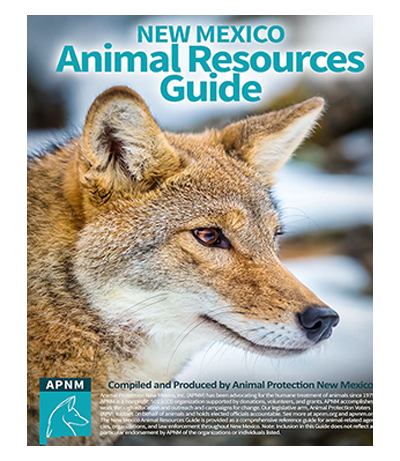
Animal Protection New Mexico’s 2018 New Mexico Animal Shelter Survey is the result of more than a year of inquiry and research designed to provide comprehensive, updated data reflecting the current state of animal sheltering in New Mexico. Animal Protection New Mexico conducted its first statewide survey in 2008 (covering 2007 data), its second, more comprehensive survey in 2012 (covering 2011 data), and this third survey in 2018 and 2019 (covering 2017 data).
OVERVIEW
Collecting and sharing data and statistics from New Mexico’s public and private animal shelters are absolute necessities in order to:
- Track trends for dogs and cats in key categories, such as intake (stray, owner-surrendered, transferred-in), live exits (adopted, returned-to-owners, transferred-out), and euthanasia;
- Evaluate the efficacy of local programs for dogs and cats;
- Provide useful comparisons of facility size and staffing within similar geographic populations;
- Identify challenges within shelters and communities;
- Spotlight the continuing urgent need for more affordable and accessible spay/neuter funding.
THE GOOD, BETTER, AND BEST NEWS
The top three takeaways compared with our last statewide survey indicate steady progress, thanks to ceaseless dedication and hard work on the frontlines of animal care and control in New Mexico:
- The number of shelter intakes decreased by 27.4%.
- The number of live exits (animals adopted, returned-to-owners, or transferred-out) increased by 16.5%.
- The number of animals euthanized decreased by 68%.
2011 and 2017 Statewide Comparative Data
The actual numbers outlined in the comparative charts below, however, demonstrate that New Mexico needs more focused community resources, including statewide support for affordable and accessible spay/neuter services in order to:
- Establish a robust safety net across the state for the still vast number of animals entering New Mexico’s shelters; and
- Reduce the senseless, preventable cycle of unwanted litters and subsequent euthanasia of cats and dogs across New Mexico.
Hover over chart columns below for details
2017 Statewide Totals
| Intake | Live Exit | Euthanasia | Euthanasia as a % of Intake | Human Population | 1,000 People | |
| Totals Reported | 91,720 | 68,723 | 16,226 | 18% | 2,088,070 | 7.78 |
| Estimated Not Reported | 8,794 | 4,102 | 4,492 | |||
| Estimated Grand Totals | 100,514 | 72,825 | 20,718 | 21% | 2,088,070 | 9.92 |
Notes: 40 facilities reported intakes; 36 of 40 facilities reported euthanasia.
2011 Statewide Totals
| Intake | Live Exit | Euthanasia | Euthanasia as a % of Intake | Human Population | Euthanasia Per 1,000 People | |
| Totals Reported | 132,058 | 62,500 | 60,545 | 46% | 2,082,224 | 29.08 |
| Estimated Not Reported | 6,441 | n/a | 4,163 | |||
| Estimated Grand Totals | 138,499 | 62,500 | 64,708 | 48% | 2,082,224 | 31.08 |
Notes: 44 facilities reported intakes; 37 of 44 facilities reported euthanasia.
THE URGENT CASE FOR MORE SPAY/NEUTER
The following statistics are of grave concern because they reveal a reality that threatens to keep New Mexico in the tragic cycle of admitting over 100,000 dogs and cats to its shelters annually.
Consider the numbers of unsterilized male and female dogs and cats reported below that likely already produced offspring before they entered the shelters:
- 58% of all shelters reporting (23 out of 40) track whether their intakes are unsterilized.
- Of their total 27,441 stray/abandoned/lost dogs and cats, 88% were unsterilized.
- Of their total 10,154 owner-surrendered dogs and cats, 82% were unsterilized.
While New Mexico’s shelter intake and euthanasia rates have declined since 2011, the problem of dog and cat overpopulation is still extreme in New Mexico. Consider the following upswing in shelter animal transfers: 35 of 40 New Mexico animal shelters (88%) reported transferring over 23,400 animals (16,674 dogs and 6,770 cats) to other shelters and rescue organizations, almost exclusively out of state, in an effort to increase the animals’ chances of being adopted into good, loving homes. This is more than double the approximately 10,000 animals reported as transferred out in 2011. Animals transferred out of state accounted for more than 1/3 of 2017’s total reported live exits (68,723). But ultimately, transporting our state’s excess animals to other states is not a long-term, sustainable approach to dog and cat overpopulation. New Mexico must be able to provide its own strong safety net for animals.
The highest numbers of animals being transferred out of shelters originated in 12 New Mexico counties: Bernalillo, Chaves, Cibola, Curry, Doña Ana, Eddy, Lea, McKinley, Rio Arriba, San Juan, San Miguel, and Valencia.
New Mexico Survey Data by County – Quick View
Hover over counties for information
NEW MEXICO’S HIGHEST INTAKES AT-A-GLANCE
The 10 shelters reporting the highest total intake numbers:
| Animal Shelter | Animal Intake |
| City of Albuquerque Animal Welfare Department | 13,560 |
| Animal Service Center of the Mesilla Valley (Las Cruces) | 11,231 |
| Farmington Regional Animal Shelter | 6,875 |
| Valencia County Animal Shelter (Los Lunas) | 5,719 |
| McKinley County Humane Society of New Mexico (Gallup) | 4,773 |
| City of Hobbs Animal Adoption Center | 4,690 |
| Grants Animal Care Center | 4,390 |
| Noah’s Ark Animal Shelter (Carlsbad) | 4,014 |
| Española Humane | 2,995 |
| Aztec Animal Shelter | 2,880 |
Geographic Areas Ranked According to Above Shelter Intake per 1000 People
While actual intake numbers are higher in New Mexico’s larger communities, the following ranking reveals how cat and dog overpopulation is much more concentrated in some other, less populated places.
| Animal Shelter | Animal Intake/1000 People |
| 1. Grants/Cibola County | 163.48 |
| 2. Carlsbad/Eddy County | 89.05 |
| 3. Española/Rio Arriba County | 76.48 |
| 4. Los Lunas/Valencia County | 75.21 |
| 5. Hobbs/Lea County | 68.21 |
| 6. Gallup/McKinley County | 65.78 |
| 7. Farmington/San Juan County | 61.51 |
| 8. Las Cruces/Doña Ana County | 52.11 |
| 9. Aztec/San Juan County | 35.35 |
| 10. Albuquerque/Bernalillo County | 24.28 |
The 5 shelters reporting the highest dog intakes:
| Animal Shelter | Dog Intake |
| City of Albuquerque Animal Welfare Department | 8,799 |
| Animal Service Center of the Mesilla Valley (Las Cruces) | 7,439 |
| Valencia County Animal Shelter (Los Lunas) | 3,960 |
| Farmington Regional Animal Shelter | 3,673 |
| McKinley County Humane Society of New Mexico (Gallup) | 3,243 |
The 5 shelters reporting the highest cat intakes:
| Animal Shelter | Cat Intake |
| City of Albuquerque Animal Welfare Department | 4,761 |
| Animal Service Center of the Mesilla Valley (Las Cruces) | 3,792 |
| Farmington Regional Animal Shelter | 3,202 |
| Grants Animal Care Center | 1,931 |
| Valencia County Animal Shelter (Los Lunas) | 1,759 |
COSTS CONTINUE TO RISE
We know that the more homeless animals there are, the higher the cost to communities to provide animal care and control services sufficient not only to protect animals, but also to protect the public from related risks such as bite injuries and fatalities, disease transmission, traffic accidents, and property damage. Associated costs for basics such as personnel, facilities, equipment, training, sheltering, and euthanasia increase proportionally. The grand total of over $51 million spending is up 34% from 2011.
Our survey clearly demonstrates a wide diversity of facilities, budgets, personnel, and animal intake across New Mexico. It is imperative that the public, state and local lawmakers, and shelters themselves have access to the survey, so everyone can see the enormity of the challenges still facing our public and private animal shelters. Only through transparency and collaboration can we hope to overcome the costly and tragic problem of companion animal overpopulation in our communities.
Animal Protection New Mexico made every effort to ensure that the information provided is accurate. We appreciate and support the efforts of all the respondents. Please contact us if you have any questions or comments.




